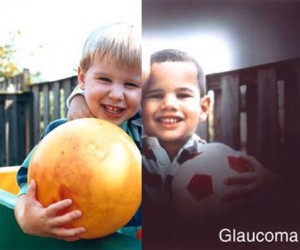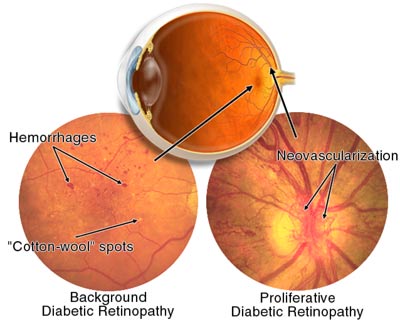There are two prominent types of vision, myopia and hyperopia. These two types affect up to 1/3 of the population and can be treated in a variety of ways.
Farsightedness aka Hyperopia
Contrary to what the name implies, a person who is farsighted has blurred vision when looking at close objects, unless they make a constant effort to focus, which can lead to strain, headaches, and eye fatigue.
What is Farsightedness?
Farsightedness or hyperopia happens when the eye is shorter than normal. This shape causes images to be focused behind the retina, rather than on it. It is a common condition that most often is inherited. As a result, the lens of the eye must exert effort to focus the image on the retina.
Babies and children are usually slightly farsighted; as their eyes grow and lengthen, the condition corrects itself, generally by age seven or eight. Young adults who remain farsighted often don’t realize their condition because they have enough flexibility in focusing power to correct the condition without the aid of eye glasses or contact lenses.
Symptoms of Farsightedness
At first, symptoms may be undetectable or very slight. With age, increased difficulty seeing near objects may be noticed until eventually even distant objects appear blurred.
Treatments for Farsightedness
Farsightedness is easy to fix, and eyes that are farsighted are otherwise healthy. Since farsightedness occurs when images are focused behind the retina, it is corrected when images are refocused onto the retina. This is usually done with common forms of vision correction, including:
- Eyeglasses or contact lenses: the simplest, most common method of vision correction
- Surgery: Surgical options are available to correct farsightedness, but can be expensive and may involve more risk than corrective eyeglasses or contact lenses. These options use either laser technology or small incisions to reshape the cornea of the affected eye.
Nearsightedness aka Myopia
A person with nearsightedness can see close objects clearly, but may have trouble seeing objects from a distance – like a road sign, blackboard, or face across the room. It’s a common condition, affecting 1 in 4 adults worldwide.
What Causes Nearsightedness?
Nearsightedness or myopia happens when the eye has a long shape, which causes light rays to focus too far in front of the retina, making distance vision difficult.
Like farsightedness, myopia can be inherited. It is often discovered when children are 8 to 12 years old. During the teenage years, when the body is growing rapidly, nearsightedness can get worse. Typically, between ages 20 and 40 there is little change.
Symptoms of Nearsightedness
An eye care professional can diagnose nearsightedness with a simple eye exam. The most common symptoms of nearsightedness include:
- Blurred distance vision
- Frequent squinting of eyes
- Eye strain or headaches from trying to focus
Treatments for Nearsightedness
Nearsightedness is easily corrected by refocusing the light rays onto the retina of the eye. This is commonly done through:
- Eyeglasses and contact lenses: The simplest treatment option chosen by most patients with nearsightedness. PureVision2 contact lenses deliver the clear, crisp vision that you should demand – designed to reduce halos and glare – especially in low light.
- Vision Shaping Treatment (Orthokeratology) – an innovative process that uses customized shaping lenses to gently correct your vision while you sleep so you can enjoy clear vision while you’re awake.
- Surgery: Surgical options are available, but can be expensive, and may involve more risk than contact lens options available. These procedures use laser technology or manual incisions to remove small amounts of tissue from the cornea.
Eye Allergies – Treatment
If avoidance of allergic triggers fails to prevent symptoms of allergic conjunctivitis, some people notice mild benefit from cold compresses on the eyes, and eyewashes with tear substitutes. However, medications may be necessary to treat the symptoms. Medications for allergic conjunctivitis include oral anti-histamines and eye drops.
Oral anti-histamines
Many people with allergic eye disease will receive benefit from oral anti-histamines, such as over-the-counter loratadine (Claritin®/Alavert®, generic forms), and prescription cetirizine (Zyrtec®), fexofenadine (Allegra® and generic forms) and desloratadine (Clarinex®). Older, first-generation anti-histamines (such as Benadryl®) are also helpful, but are generally considered too sedating for routine use.
Over-the-counter eye drops
Medicated eye drops are available in over-the-counter and prescription forms. Over-the-counter eye drops for allergic conjunctivitis are currently only available in decongestant (Visine®, Naphcon®, generic forms of naphazoline), and decongestant/anti-histamine combinations (Visine-A®, Naphcon-A®, generic forms of naphazoline/pheniramine).
Decongestant eye drops (with or without anti-histamines) should only be used for short periods of time, as overuse can lead to conjunctivitis medicamentosa (characterized as rebound eye redness/congestion and dependence on the eye drops). These eye drops should not be used by people with glaucoma, and used with caution by people with heart or blood pressure problems. Continue reading
Eye Allergies
 Eye allergies often are hereditary, and occur due to processes associated with other types of allergic responses. When an allergic reaction takes place, your eyes may be overreacting to a substance perceived as harmful, even though it may not be. These substances are called allergens. For example, dust that is harmless to most people can cause excessive production of tears and mucus in eyes of overly sensitive, allergic individuals.
Eye allergies often are hereditary, and occur due to processes associated with other types of allergic responses. When an allergic reaction takes place, your eyes may be overreacting to a substance perceived as harmful, even though it may not be. These substances are called allergens. For example, dust that is harmless to most people can cause excessive production of tears and mucus in eyes of overly sensitive, allergic individuals.
What Causes Eye Allergies?
Many allergens are in the air, where they come in contact with your eyes and nose. Airborne allergens include pollen, mold, dust and pet dander. Other causes of allergies, such as certain foods or bee stings, do not typically affect the eyes the way airborne allergens do. Adverse reactions to certain cosmetics or drugs such as antibiotic eye drops also may cause eye allergies. Some people actually are allergic to the preservatives in eye drops such as those used to lubricate dry eyes. In this case, you may need to use a preservative-free brand.
Seasonal allergic conjunctivitis (SAC) is the most common form of eye allergy, with grass and ragweed pollens being the most important seasonal triggers. Perennial allergic conjunctivitis (PAC) is also very common. Animal dander, feathers, and dust mites are common triggers in PAC.
Use It. Don’t Lose It.
Use your FSA Health Benefits Dollars Before December 31
If you participate in a Flexible Spending Account (FSA) through your employer’s “Cafeteria Plan” benefits program, time may be running out. Some plans require the money you contributed to be spent by December 31, or you risk losing it. Here is a list of vision-related services and expenses that may qualify for reimbursement:
- Eye Health Examination
- Contact Lenses
- Eyeglasses
- Prescription Sunglasses
- Laser Vision Correction
Please check with your plan administrator to determine the specific requirements of your plan. Beat the year-end rush. Call 210-732-3200 to schedule your appointment today.
Glaucoma
Glaucoma refers to a group of eye disorders that usually have few or no initial  symptoms and eventually cause harm to the optic nerve that carries information from the eye to the brain.
symptoms and eventually cause harm to the optic nerve that carries information from the eye to the brain.
In most cases, glaucoma is associated with higher-than-normal pressure inside the eye (ocular hypertension). If untreated or uncontrolled, glaucoma first causes peripheral vision loss and eventually can lead to blindness.
According to the American Academy of Ophthalmology (AAO), the most common type of glaucoma — called primary open-angle glaucoma — affects an estimated 2.2 million people in the United States, and that number is expected to increase to 3.3 million by 2020 as the U.S. population ages.
Also, open-angle glaucoma is three times more likely to affect African-Americans, compared with non-Hispanic whites in the United States, and blindness from glaucoma is at least six times more prevalent among African-Americans than non-Hispanic whites. Studies also suggest open-angle glaucoma affects Hispanics and Latinos at comparable rates to African-Americans.
Globally, glaucoma is the second leading cause of blindness (behind cataracts), according to the World Health Organization.
My child won’t wear his glasses. What can I do?
There could be many reasons why your child won’t wear the glasses prescribed. The first thing you should do is have the fit of the glasses checked; no one wants to wear glasses that are uncomfortable. Next, have the prescription checked by the person who prescribed the glasses. If the glasses fit properly and the prescription is correct then it may be that the feel of the glasses, and seeing clearly are simply unfamiliar experiences. It may be asking too much to expect your child to wear the glasses all of the time in the early stages. Make sure that you understand what the glasses are for, and when it is most important for your child to wear them.
You can then encourage your child to wear his/her glasses in a number of ways:
- put the glasses on when he/she is doing an activity with you that is enjoyable. This way your child will learn to associate wearing glasses with a pleasant experience. If necessary, make it a short experience, and build up time gradually.
- put the glasses on in front of a mirror so that your child sees themselves with the glasses on. Children like looking at their own reflection and often forget they have glasses on.
- if you or another member of the family wears glasses, make a big show of putting them on for particular tasks. Most children love to copy others.
- if your child won’t wear their glasses at home then perhaps he/she will wear them at school. Chat to the class teacher and ask for his/her help in trying to persuade your child to keep the glasses on.
Some children do not like objects near their face. Others do not like change. But once your child learns that the glasses will not hurt and gets used to seeing more clearly, he/she will be happy to wear them. Start slowly and build up the wearing time gradually. If your child still refuses to wear his/her glasses, don’t turn it into a battle. Children learn quickly that a great way to get attention from parents is to throw their glasses across the room. What a great game! Most children grow out of their reluctance to wear glasses. Continue to take your child for routine eye exams annually and discuss any concerns with the optometrists.
What parents need to know about their childs vision
Children’s vision care is essential to every child’s development. Most of what a child learns  in school is presented visually, so making sure your son or daughter has good vision as it can make a big difference in their academic performance.
in school is presented visually, so making sure your son or daughter has good vision as it can make a big difference in their academic performance.
Taking your child to an optometrist for a routine eye exam can result in detection of any nearsightedness, farsightedness and/or astigmatism your child has so that it can be promptly treated with eyeglasses or contact lenses. I have seen several children with vision problems that have never had a routine exam done before. Routine exams are also needed to make sure your child’s eyes are healthy and to rule out other potential problems including amblyopia, strabismus and other binocular vision problems that may interfere with your child’s vision development, academic performance and sports vision.
According to the American Optometric Association (AOA), infants should have their first comprehensive eye exam at 6 months of age. Children then should have additional eye exams at age 3, and just before they enter the first grade. For school-aged children, the AOA recommends an eye exam every two years if no vision correction is required. Children who need eyeglasses or contact lenses should be examined annually or as recommended by their optometrist.
Diabetic Retinopathy
Diabetes is a disease that interferes with the body’s ability to use and store sugar and can cause many health problems. One, called diabetic retinopathy, can weaken and cause changes in the small blood vessels that nourish your eye’s retina, the delicate, light sensitive lining of the back of the eye. These blood vessels may begin to leak, swell or develop brush-like branches. In the early stages of diabetes, patients don’t know they have a problem; in the worst cases,diabetic retinopathy can blind patients.
In some cases, fluid leakage in the central area of the retina can cause distorted or blurred vision in the early stages, and central vision loss if it progresses to end stage. In other cases, new blood vessel growth in any part of the retina can scar and shrink, leading to retinal detachment causing blindness.
Treatment of Diabetic Eye Disease
If left untreated, diabetic retinopathy can lead to blindness. Diabetics are encouraged to take their prescribed medication as directed by their physician, exercise regularly, watch their diet, and have regular eye examinations in order to help prevent diabetic retinopathy. A timely referral may be made to a specialist for surgery to help preserve vision.
To detect diabetic retinopathy, your optometrist can look inside your eyes with an instrument called an ophthalmoscope that lights and magnifies the blood vessels in your eyes. If you have diabetic retinopathy, laser and other surgical treatments can be used to reduce its progression and decrease the risk of vision loss. Early treatment is important because once damage has occurred, the effects are usually permanent.
Prevention of Diabetes in Your Eyes
Call 210-826-3937 to schedule a comprehensive eye examination today. Only a thorough eye examination is able to look for changes in the eye as a result of the disease. Maintaining good blood sugar control can delay or prevent the serious consequences of diabetic retinopathy.


